Attached files
| file | filename |
|---|---|
| EX-99.1 - EX-99.1 - WELLS FARGO & COMPANY/MN | f57972exv99w1.htm |
| 8-K - FORM 8-K - WELLS FARGO & COMPANY/MN | f57972e8vk.htm |
Exhibit 99.2

| 4Q10 Quarterly Supplement January 19, 2011 (c) 2011 Wells Fargo & Company. All rights reserved. |
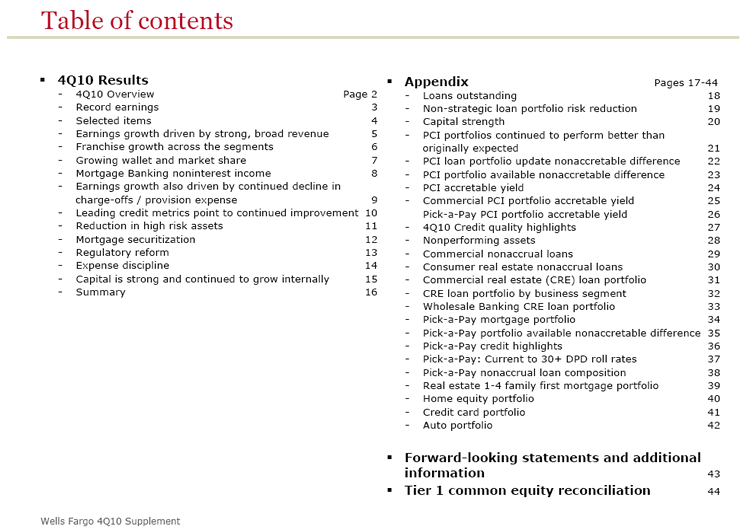
| Appendix Pages 17-44 Loans outstanding 18 Non-strategic loan portfolio risk reduction 19 Capital strength 20 PCI portfolios continued to perform better than originally expected 21 PCI loan portfolio update nonaccretable difference 22 PCI portfolio available nonaccretable difference 23 PCI accretable yield 24 Commercial PCI portfolio accretable yield 25 Pick-a-Pay PCI portfolio accretable yield 26 4Q10 Credit quality highlights 27 Nonperforming assets 28 Commercial nonaccrual loans 29 Consumer real estate nonaccrual loans 30 Commercial real estate (CRE) loan portfolio 31 CRE loan portfolio by business segment 32 Wholesale Banking CRE loan portfolio 33 Pick-a-Pay mortgage portfolio 34 Pick-a-Pay portfolio available nonaccretable difference 35 Pick-a-Pay credit highlights 36 Pick-a-Pay: Current to 30+ DPD roll rates 37 Pick-a-Pay nonaccrual loan composition 38 Real estate 1-4 family first mortgage portfolio 39 Home equity portfolio 40 Credit card portfolio 41 Auto portfolio 42 Forward-looking statements and additional information 43 Tier 1 common equity reconciliation 44 Table of contents 4Q10 Results 4Q10 Overview Page 2 Record earnings 3 Selected items 4 Earnings growth driven by strong, broad revenue 5 Franchise growth across the segments 6 Growing wallet and market share 7 Mortgage Banking noninterest income 8 Earnings growth also driven by continued decline in charge-offs / provision expense 9 Leading credit metrics point to continued improvement 10 Reduction in high risk assets 11 Mortgage securitization 12 Regulatory reform 13 Expense discipline 14 Capital is strong and continued to grow internally 15 Summary 16 |

| 4Q10 Overview Earnings and Franchise Growth Continuation of record earnings on broad based 12% annualized revenue growth; loans up and checking/savings deposit growth accelerated Credit Quality Significant improvement in credit quality with lower net charge-offs and lower NPAs PCI portfolios continued to perform better than originally expected Mortgage Securitizations Mortgage repurchase demands declined for both agency and non-agency securitizations with total outstanding demands down ~40% from 2Q10 peak Adequate $1.3 billion repurchase reserve Percent changes from 3Q10. (1) Shareholders' equity. 2 Regulatory Reform 4Q10 costs and evolving strategy Capital Position Highest ever capital position (1) on 12% annualized internal capital generation Objective is to increase dividend, repurchase shares and redeem callable TRUPS upon regulatory approval |

| Record earnings... 3 $3.4 billion record quarterly NIAT (1) up 21% YoY, 9% linked quarter annualized (LQA) $24.6 billion earned since Wachovia merger $0.61 per share Net Income ($ in billions) (1) Net income after tax. |

| Selected items (1) Approximate quarterly impact of changes to Regulation E and related overdraft policy changes. (2) Represents release of nonaccretable difference. (3) Includes merger integration expense of $40 million for 3Q10 and $70 million for 4Q10. (4) Reserve release represents the amount by which net charge-offs exceed the provision for credit losses. 4 Additional mortgage repurchase reserves, foreclosure expenses and origination expenses (see page 8) |

| Earnings growth driven by strong, broad revenue 5 $21.5 billion quarterly revenue, up 12% linked quarter annualized (LQA) 60% of revenue came from businesses with > 10% LQA growth Growth across the franchise: Period end loans up 2% LQA, up 6% LQA excluding $6.0 billion reduction in non- strategic loans (1) Mortgage originations up 27% Accelerating checking/savings deposits up 17% annualized Wealth, Brokerage and Retirement client assets up 12% annualized Trust and investment fees up 15% Revenue ($ in billions) 21.0 22.5 22.5 22.7 21.4 21.4 20.9 21.5 Percent changes from 3Q10. (1) See pages 18-19 for additional information on the non-strategic/liquidating loan portfolio. |

| Franchise growth across the segments 6 Community Banking NIAT = $2.0B; ROA= 1.01% Revenue = $13.5B, +1.3% LQA Core product solutions (1) +17% YoY Store-based small business solutions(1) +28% YoY Avg core deposits +5% LQA Consumer checking accts +7.5% YoY Small business checking accts +4.8% YoY Mortgage originations $128B, up 27% from 3Q10 Linked quarter loan growth in mortgage, auto loans, private student lending and SBA lending Diverse sources of revenue growth LQA Mortgage banking +30% Debit card +21% Auto dealer services +28% Global remittance +82% SBA loans +26% (1) Legacy Wells Fargo, includes converted Wachovia stores in legacy Wells Fargo footprint. Wholesale Banking NIAT = $1.6B; ROA= 1.70% Revenue = $5.8B, +32.3% LQA Avg loans +4% LQA, growth in commercial banking, CRE, asset backed finance, capital finance, government banking, equipment finance and international Avg core deposits +33% LQA Diverse sources of revenue growth LQA Commercial banking +24% Investment banking +71% Equipment finance +39% CMO +105% Shareowner services +45% CRE +41% Real estate brokerage +397% Capital finance +37% Asset management +14% Insurance +125% International +23% Wealth, Brokerage & Retirement NIAT = $0.2B; ROA= 0.56% Revenue = $3.0B, +17.6% LQA Client assets of $1.3 trillion, +12% LQA Managed account assets +30% LQA Linked quarter loan growth in brokerage lines of credit, +18% LQA Avg core deposits +3% LQA Diverse sources of revenue growth LQA Brokerage +19% Wealth mgmt +24% |

| Growing wallet and market share Retail Bank Cross-sell (1) 7 Market share growth across the franchise Strong and geographically broad based 4Q10 YoY consumer checking account growth Total WFC up 7.5% California up 8.2% Florida up 10.0% (1) Cross-sell for the East includes Wachovia stand alone states except for Kansas and for the West includes legacy Wells Fargo states, including overlapping states and Kansas. (2) Most recent quarter available. (3) Inside Mortgage Finance, 1Q09 vs. 3Q10. (4) College Board Statistics. Private Educational Loans 2009 vs. 2010 academic year. (5) AutoCount. FY2010 vs. FY2009. (6) Thomson Reuters, 1Q09 vs. 4Q10. (7) PLANSPONSOR Magazine's annual Recordkeeping Survey. (8) Represents Wells Fargo's fees/deposits as a % of total fees/deposits earned by WFC and its peers (BAC, BBT, C, COF, FITB, JPM, KEY, PNC, RF, STI, & USB). Data from FRY 9-C filings in SNL Financial. (9) SNL Financial. (10) Adjusted for loans brought on balance sheet through VIE consolidations per FAS 167's directive, which was implemented on 1/1/10. |

| Mortgage Banking noninterest income 8 (1) Net gain on mortgage loan origination/sales activities before additions to repurchase reserve. (2) Servicing fees net of changes in fair value due to collection/realization of expected cash flows over time, amortization and provision for MSRs in excess of fair value. (3) Market-related valuation changes to MSR, net of hedge results, and MSR valuation changes for higher projected servicing and foreclosure costs. |

| ...earnings growth also driven by continued decline in charge-offs / provision expense 9 $3.8 billion net charge-offs, down 29% from 4Q09 peak Provision expense of $3.0 billion, down $456 million from 3Q10 ($256 million fewer losses and $200 million higher reserve release) $2.1 billion decline in NPLs from 3Q10 $1.1 billion decline in inflows $1.5 billion increase in outflows Allowance for credit losses = $23.5 billion = 6.11x quarterly charge-offs Remaining PCI nonaccretable = 29.5% of remaining UPB (1) Provision Expense ($ in billions) (0.50) (0.65) (0.85) Reserve Release 3.99 3.45 2.99 5.33 5.91 6.11 4.56 5.09 (1) Unpaid principal balance for PCI loans that have not had a UPB charge-off. |
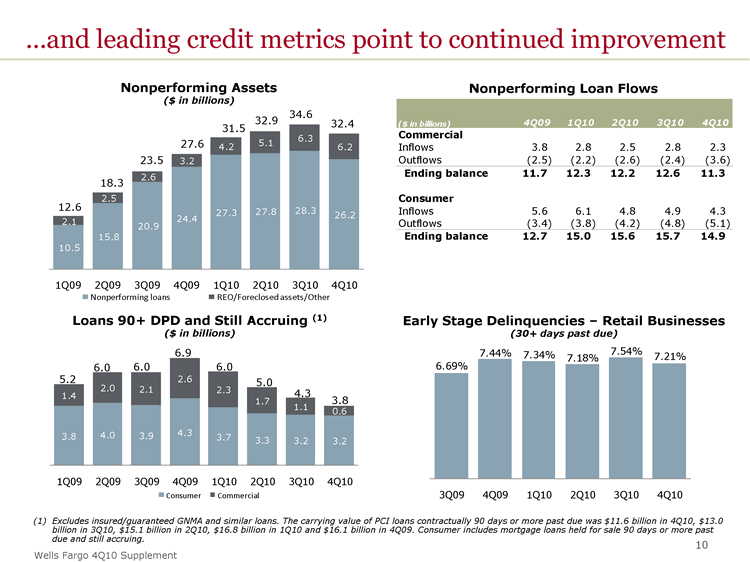
| ...and leading credit metrics point to continued improvement Loans 90+ DPD and Still Accruing (1) ($ in billions) Excludes insured/guaranteed GNMA and similar loans. The carrying value of PCI loans contractually 90 days or more past due was $11.6 billion in 4Q10, $13.0 billion in 3Q10, $15.1 billion in 2Q10, $16.8 billion in 1Q10 and $16.1 billion in 4Q09. Consumer includes mortgage loans held for sale 90 days or more past due and still accruing. 10 Nonperforming Assets ($ in billions) 6.9 3.8 4.3 5.0 6.0 Early Stage Delinquencies - Retail Businesses (30+ days past due) Nonperforming Loan Flows 6.0 6.0 5.2 32.4 34.6 32.9 31.5 27.6 23.5 18.3 12.6 |
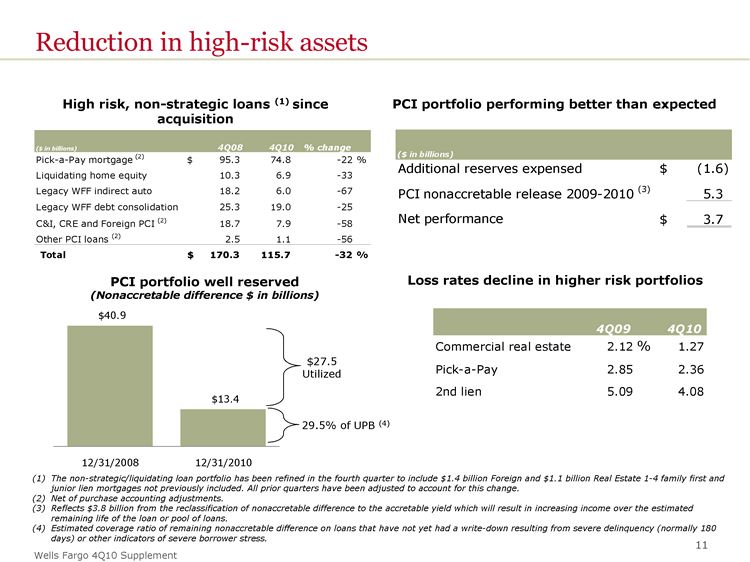
| Reduction in high-risk assets 11 Loss rates decline in higher risk portfolios PCI portfolio performing better than expected High risk, non-strategic loans (1) since acquisition $27.5 Utilized 29.5% of UPB (4) (1) The non-strategic/liquidating loan portfolio has been refined in the fourth quarter to include $1.4 billion Foreign and $1.1 billion Real Estate 1-4 family first and junior lien mortgages not previously included. All prior quarters have been adjusted to account for this change. (2) Net of purchase accounting adjustments. (3) Reflects $3.8 billion from the reclassification of nonaccretable difference to the accretable yield which will result in increasing income over the estimated remaining life of the loan or pool of loans. (4) Estimated coverage ratio of remaining nonaccretable difference on loans that have not yet had a write-down resulting from severe delinquency (normally 180 days) or other indicators of severe borrower stress. PCI portfolio well reserved (Nonaccretable difference $ in billions) |

| Mortgage securitization Residential Mortgage Servicing Portfolio $1.8 Trillion (as of December 31, 2010) 12 3Q10 Delinquency Performance (1) (Data as of September 30, 2010) Non-agency securitizations of WFC originated loans ~70% jumbo loans 81% prime at origination 58% from pre-2006 vintages Insignificant amount of home equity ~50% do not have traditional reps and warranties Total non-agency $137 million of non-agency repurchases in 4Q10 New non-agency demands based on loan count have declined for three consecutive quarters As of 12/31/2010. Agency Retained and acquired portfolio Non-agency securitizations of WFC originated loans Non-agency acquired servicing and private whole loan sales (1) Inside Mortgage Finance. (2) Industry is all large servicers ($6.9 trillion) including WFC, C, JPM and BAC. Total Outstanding Agency Repurchase Demands and New Demands for 2006-2008 Vintages Wells Fargo total delinquency and foreclosure ratio for 4Q10 was 8.02%, down from a peak of 8.96% in 4Q09 (2) |

| Regulatory reform (1) 13 (1) Reflects management's current estimates. Estimates are subject to change - see "Forward-looking statements" on page 43. (2) After-tax, with estimated offsets. Regulation E $270 million after-tax in 4Q10, expect lower quarterly effect in 2011 of $215-$240 million after-tax (2) Credit Card $50 million after-tax in 4Q10; already in earnings run rate FDIC Additional $40 million after-tax per quarter expected starting 2Q11; substantially less than wholesale-funded banks Recapture over time expected to come from a combination of product changes, pricing changes, expense efficiencies and organic growth with our customers |

| Expense discipline 14 (1) Includes merger integration expense of $70 million for 4Q10. |

| Capital is strong and continued to grow internally Internal capital generation in 4Q10 = 12% annualized ($3.5 billion) Tier 1 common +36 bps in 4Q10 31 bps due to retained earnings 8 bps due to other internal sources of capital (3) bps due to change in risk-weighted assets Other capital ratios growing Tier 1 Capital = 11.25% Tier 1 Leverage = 9.19% Tier 1 common under Basel II/III = 6.9% (1) at 12/31/10 Objective: increase dividend, repurchase shares, redeem callable TRUPS upon regulatory approval Appendix page 44 has more information on Tier 1 common equity. 4Q10 capital ratios are preliminary estimates. (1) Pro forma calculations based on reported Tier 1 common equity, as adjusted to reflect management's interpretation of current Basel III capital proposals. These pro forma calculations and management's estimates are subject to change depending on final promulgation of Basel III capital rulemaking and interpretations thereof by regulatory authorities. Tier 1 Common Equity Ratio 15 2001-2007 Avg = 7.0% |
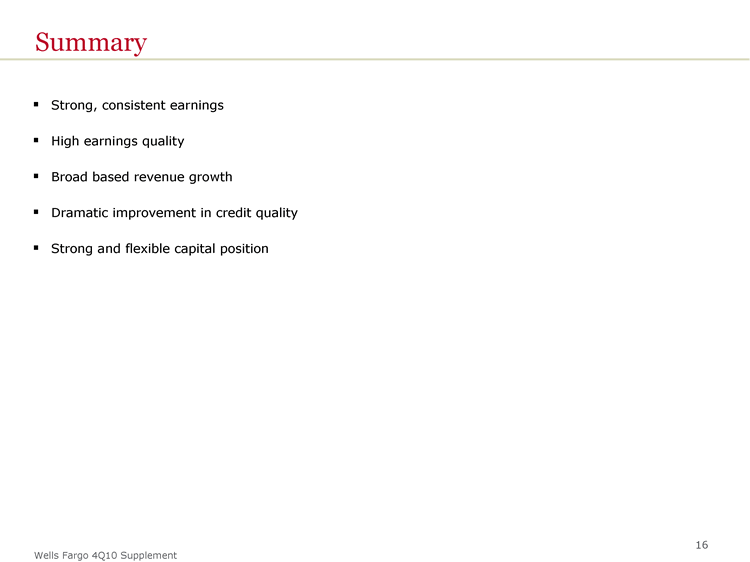
| Strong, consistent earnings High earnings quality Broad based revenue growth Dramatic improvement in credit quality Strong and flexible capital position Summary 16 |

| Appendix 17 |

| Loans outstanding Loans increased $3.6 billion, or 0.5%, from 3Q10 All other loans up $9.6 billion, or 6% LQA, excluding $6.0 billion decline in the non- strategic portfolio (Pick-a-Pay, liquidating, home equity, indirect auto, debt consolidation, all other PCI loans) Period-end balances. (1) Please see page 19 for additional information regarding the non-strategic/liquidating portfolio, which comprises the Pick-a-Pay, liquidating home equity, legacy WFF indirect auto, legacy WFF debt consolidation and Commercial and Commercial Real Estate PCI loan portfolios. 800.0 782.8 781.4 766.3 (1) 753.7 821.6 18 Period-end Loans Outstanding ($ in billions) 843.6 757.3 |

| (1) The non-strategic/liquidating loan portfolio has been refined this quarter to include $1.4 billion Foreign and $1.1 billion Real Estate 1-4 family first and junior lien mortgage not previously included. All prior quarters have been adjusted to account for this change. (2) Net of purchase accounting adjustments. -$28.3 -$6.7 -$7.2 Non-strategic loan portfolio (1) risk reduction 19 -$6.4 -$6.0 |

| 36 bps increase in Tier 1 common equity ratio in 4Q10, all internally generated (1) December 31, 2010, capital ratios are preliminary. (2) See table on page 44 for more information on Tier 1 Common Equity. Capital strength 20 |

| Purchased credit-impaired (PCI) portfolios continued to perform better than originally expected (1) Does not reflect charge-offs and certain other charges against the nonaccretable difference. (2) Reflects $3.8 billion from the reclassification of nonaccretable difference to the accretable yield which will result in increasing income over the estimated remaining life of the loan or pool of loans. 21 |

| (1) Release of the nonaccretable difference for settlement with borrower, on individually accounted PCI loans, increases interest income in the period of settlement. Pick-a-Pay and Other consumer PCI loans do not reflect nonaccretable difference releases due to pool accounting for those loans, which assumes that the amount received approximates the pool performance expectations. (2) Release of the nonaccretable difference as a result of sales to third parties increases noninterest income in the period of the sale. (3) Reclassification of nonaccretable difference for increased cash flow estimates to the accretable yield will result in increasing income over the estimated remaining life of the loan or pool of loans and thus the rate of return realized. (4) Write-downs to net realizable value of PCI loans are absorbed by the nonaccretable difference when severe delinquency (normally 180 days) or other indications of severe borrower financial stress exist that indicate there will be a loss of contractually due amounts upon final resolution of the loan. $99 million nonaccretable difference released in 4Q10 into income due to loan resolutions $78 million in net interest income; $21 million in noninterest income $165 million reclassified to accretable yield in 4Q10 for commercial loans with improving cash flows reflecting better than expected performance, expected to accrete to income over estimated remaining expected life of underlying loans $13.4 billion in nonaccretable difference remains to absorb losses on PCI loans Nonaccretable difference established in purchase accounting for PCI loans absorbs losses otherwise recorded as charge-offs Purchased credit-impaired (PCI) loan portfolio update Nonaccretable difference in 4Q10 22 |

| Purchase credit-impaired (PCI) portfolio Available nonaccretable difference Represents contractual unpaid principal balance (UPB) of $18.9 billion for which write-downs of $9.6 billion have been absorbed by the nonaccretable difference to reflect their severe delinquency (normally 180 days) or other indications of severe borrower stress that indicate there will be a loss of contractually due amounts upon final resolution of the loan. 23 |

| PCI accretable yield 4Q10 results include interest income of $578 million compared with $528 million in 3Q10 Balance of $16.7 billion expected to accrete to income over the remaining life of the underlying loans Expected cash flows on all PCI portfolios are recalculated quarterly including the adequacy of life-of-loan loss marks (nonaccretable difference) Estimates of redefaults on our Pick-a-Pay loan modifications While there is some underlying volatility in assumptions on a quarterly basis, total PCI cash flows have increased since acquisition (1) Represents changes in interest cash flows due to the impact of modifications incorporated into the quarterly assessment of expected future cash flows and/or interest rates on variable rate PCI loans. 24 |

| $1.2 billion remains to be accreted into income over 1.8 years (the estimated remaining weighted average life of the portfolio) Increase from 3Q10 reflects the reclassification to accretable yield from nonaccretable of $165 million during the quarter Most of portfolio tied to LIBOR Weighted average life of the portfolio of 1.8 years has held relatively consistent over the past couple of quarters as shorter duration portfolios have rolled off and period of future cash flow assumptions have been extended Commercial PCI portfolio accretable yield 25 |

| $14.6 billion remains to be accreted over 9.4 years (the estimated remaining weighted average life of the portfolio) Based on updated cash flow valuations, there was no reclassification of nonaccretable to accretable in 4Q10 Quarterly fluctuations in accretable yield can be driven by changes in: Interest rate indices for variable rate PCI loans Prepayment assumptions Expected principal and interest payments over the estimated life While the accretable yield balance is expected to be earned over the estimated remaining life of the loans, the accretable yield percentage is also affected by the quarterly updates to projected timing of cash flow events including REO liquidations, short sales, modifications and prepayments Pick-a-Pay PCI portfolio accretable yield 26 |

| 4Q10 Credit quality highlights Allowance for credit losses $23.5 billion 1.54x annualized quarterly charge-offs 3.10% of total loans $13.4 billion in nonaccretable difference for PCI portfolio in addition to allowance Provision expense declined $456 million and was $850 million less than net charge-offs in the quarter Net charge-offs of $3.8 billion down $256 million from 3Q10 Commercial losses declined $111 million on lower losses in all loan categories Consumer losses down $145 million on declines in junior lien mortgage, credit card and Pick-a-Pay Currently expect additional reserve releases in coming quarters absent significant deterioration in the economy 27 |

| Nonperforming assets Commercial nonaccruals of $11.4 billion 95% secured and approximately 65% guaranteed Over 57% are currently paying interest that is applied to principal $2.6 billion in losses taken to date Consumer nonaccruals of $14.9 billion > 99% secured Approximately 41% of nonaccrual loans have been written down 33% CLTV (1) below 80% $4.0 billion in losses taken to date $14.0 billion of troubled debt restructurings (TDRs), including $4.0 billion of nonaccrual TDRs, have $3.7 billion of loan impairment for expected life-of-loan loss reserves Foreclosed assets down $118 million 58% of the balance are government guaranteed loans and loans written down through purchase accounting $1.5 billion, or 25%, are government guaranteed $2.0 billion, or 33%, reflects shift from PCI loans to REO ($1.0 billion consumer and $967 million commercial and CRE) Remainder represents real estate loans (residential and CRE) and have already been written down The current loan-to-value (CLTV) ratio is calculated as the outstanding loan balance divided by the collateral value. The table above does not include PCI loans that were contractually 90 days past due and still accruing. Also excludes GNMA and similar loans whose repayments are insured by the Federal Housing Administration or guaranteed by the Department of Veterans Affairs. 28 |
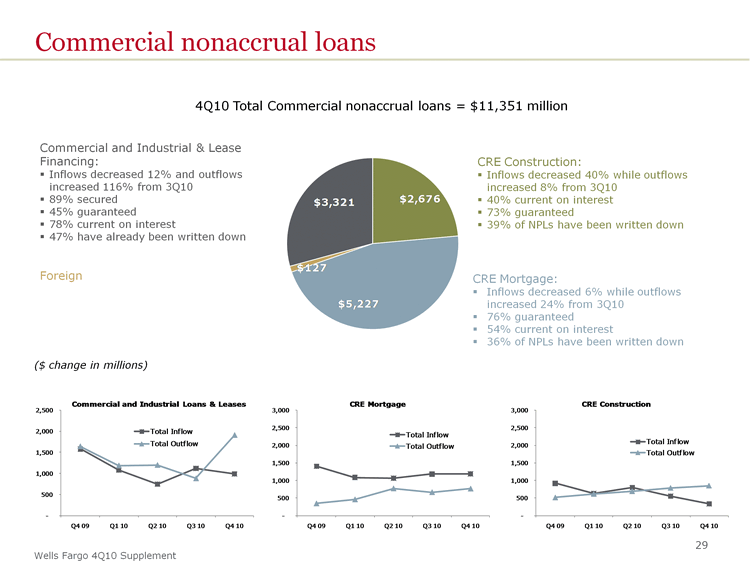
| Commercial nonaccrual loans 4Q10 Total Commercial nonaccrual loans = $11,351 million ($ change in millions) 29 Foreign Commercial and Industrial & Lease Financing: Inflows decreased 12% and outflows increased 116% from 3Q10 89% secured 45% guaranteed 78% current on interest 47% have already been written down CRE Mortgage: Inflows decreased 6% while outflows increased 24% from 3Q10 76% guaranteed 54% current on interest 36% of NPLs have been written down CRE Construction: Inflows decreased 40% while outflows increased 8% from 3Q10 40% current on interest 73% guaranteed 39% of NPLs have been written down |

| Consumer real estate nonaccrual loans National Home Equity (1): Inflows decreased 9% while outflows increased 3% 44% are 1-4 family first mortgage 19% are TDRs for which impairment has been recognized Other Businesses: 78% is WFF debt consolidation Inflows increased 3% while outflows increased 18% 40% have been written down 11% is WBR Inflows decreased 33% while outflows decreased 57% Home Mortgage: Inflows decreased 26% while outflows increased 7% 56% have already been written down 55% are > 180 DPD Pick-a-Pay: Inflows declined 8% while outflows rose 9% 81% of NPLs held at current estimated recoverable value 19% are TDRs for which impairment has been recognized See page 38 for additional information 4Q10 Total residential real estate nonaccrual loans = $14,591 million ($ change in millions) All comparisons are to 3Q10. (1) Includes National Home Equity first and junior lines and loans. 30 |

| Commercial real estate (CRE) loan portfolio Office Industrial, Warehouse Other RE Apartment Retail (Ex Shopping Ctr) Land (Ex 1-4 Family) Shopping Ctr 1-4 Family Structure Hotel/Motel 1-4 Family Land Institutional 2% Agriculture Retail CA FL TX NC GA NY VA AZ NJ CO Other 33% of the portfolio is owner-occupied 31 CRE loans by property type CRE loans by geography |

| CRE loan portfolio by business segment Wholesale Banking 15% owner-occupied Community Banking 61% owner-occupied Wealth, Brokerage & Retirement (WBR) 37% owner-occupied 32 |

| Wholesale Banking CRE loan portfolio (1) Wholesale CRE outstandings of $82.3 billion (1) down $344 million from 3Q10 CRE Division portfolio = $61.4 billion, down $227 million NPAs decreased $305 million from 3Q10 while losses declined $42 million, or 27 bps, from 3Q10 Wachovia PCI CRE portfolio = $6.8 billion carrying value down $970 million, or 13%, from 3Q10 Losses declined $104 million from 3Q10 4Q10 revenue included release of nonaccretable difference for commercial PCI resolutions (payoffs/sales) of $84 million in the quarter vs. $188 million in 3Q10 on improved borrower liquidity and higher collateral asset values Foreclosed assets/REO/Other decreased $79 million from 3Q10 CRE loans originated through other Wholesale Banking channels (both legacy Wells Fargo and Wachovia) = $14.2 billion, up $853 million from 3Q10 Nonaccruals down while losses increased from 3Q10 though remain low at 48 bps Includes $8.3 billion in C&I loans managed by commercial real estate business including unsecured loans to real estate developers not secured by real estate and loans to REITs, as well as foreign and consumer loans. 33 |

| Pick-a-Pay mortgage portfolio Carrying value of $74.8 billion in first lien loans outstanding, down $2.5 billion from 3Q10 and down $20.5 billion from 4Q08 on paid-in-full loans and loss mitigation efforts Unpaid principal balance of $89.6 billion, down $3.4 billion from 3Q10 and down $27.7 billion since acquisition $3.7 billion in modification principal forgiveness since acquisition reflects over 80,400 completed full-term modifications Pick-a-Pay loans with negative amortization potential decreased $4.4 billion from 3Q10 to 60% of loans Total portfolio deferred interest of $2.7 billion down $251 million from 3Q10 and down $1.7 billion from 4Q08; down for the seventh consecutive quarter Expect minimal recast risk over next 3 years due to product structure and features Approximately $37 million, or 175 loans, expected in 2011, approximately $72 million, or 282 loans, expected in 2012 and approximately $307 million or 1,033 loans in 2013 Modification redefault rate has been consistently better than the industry average as we have strived to give customers an affordable, sustainable payment 34 |

| Pick-a-Pay portfolio Available nonaccretable difference Represents contractual unpaid principal balance (UPB) of $10.7 billion for which write-downs of $4.4 billion have been absorbed by the nonaccretable difference to reflect their severe delinquency (normally 180 days) or other indications of severe borrower stress that indicate there will be a loss of contractually due amounts upon final resolution of the loan. 35 |

| Pick-a-Pay credit highlights Pick-a-Pay non-PCI portfolio Loans down 3% driven by loans paid-in-full 85% of portfolio current Nonaccrual loans down $278 million QoQ for the second consecutive quarter 81% of loans have been written down to current net realizable value (See page 38) New inflows of $0.9 billion vs. $1.0 billion in 3Q10 declined for a fourth consecutive quarter $446 million of nonaccrual TDRs have been reclassified to accruing TDR status based on borrower payment performance $4.1 billion in nonaccruals included $772 million of nonaccruing TDRs of which 50% were paying as agreed Net charge-offs down $8 million to 2.36% reflecting stabilizing credit trends 30-150 DPD continued to decline throughout 2010 43% of portfolio with LTV (2) < 80% Pick-a-Pay PCI portfolio Carrying value down 4% 62% of portfolio current, 150 bps improvement from 3Q10 Life-of-loan losses continued to be lower than originally projected at time of merger The carrying value, which does not reflect the allowance for loan losses, includes purchase accounting adjustments, which, for PCI loans, are the nonaccretable difference and the accretable yield, and for all other loans, an adjustment to mark the loans to a market yield at date of merger less any subsequent charge-offs. The current loan-to-value (LTV) ratio is calculated as the unpaid principal balance divided by the collateral value. The current loan-to-value (LTV) ratio is calculated as the net carrying value loan balance divided by the collateral value. The September 30, 2010 LTV has been revised to remove the UPB of any equity lines of credit that share collateral from the calculation of the LTV ratio to conform to the 4Q10 presentation. 36 |
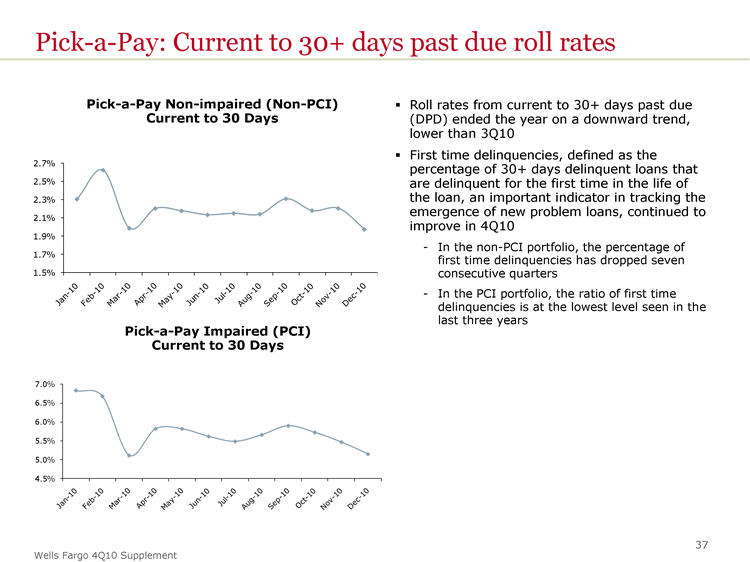
| Pick-a-Pay Non-impaired (Non-PCI) Current to 30 Days Pick-a-Pay Impaired (PCI) Current to 30 Days Roll rates from current to 30+ days past due (DPD) ended the year on a downward trend, lower than 3Q10 First time delinquencies, defined as the percentage of 30+ days delinquent loans that are delinquent for the first time in the life of the loan, an important indicator in tracking the emergence of new problem loans, continued to improve in 4Q10 In the non-PCI portfolio, the percentage of first time delinquencies has dropped seven consecutive quarters In the PCI portfolio, the ratio of first time delinquencies is at the lowest level seen in the last three years Pick-a-Pay: Current to 30+ days past due roll rates 37 |

| Pick-a-Pay nonaccrual loan composition (1) 81% of Pick-a-Pay nonaccruals held at estimated recoverable value, consistent with 3Q10, reflecting write-downs and/or LTV ^100% Allowance available for the remaining 19% that have not yet been written down 9% of the nonaccruals are performing modifications Performing modifications move to accruing status after six consecutive payments are made 4Q10 Total $4,094 million 180 DPD written down to estimated recoverable value Charge-offs to date of $674 million (28% of original balance) 180 DPD updated LTV ^100% No charge-offs to date 65% of loans have LTV<80% 34% of loans have LTV^80% but <100% 1% of loans have LTV^100% (2) 0 -179 DPD Initial charge-offs usually not taken until 180 DPD ($51 million taken to date) Expected losses included in allowance Loan modifications (TDRs) Charge-offs/principal forgiveness to date of $165 million (18% of original balance) Additionally, we hold expected life-of-loan loss reserves in allowance LTV is considered to be over 100% if the loan balance exceeds current estimated appraised value based on automated valuation methodology or updated appraisal where available. Calculation excludes unpaid principal balance of related equity lines of credit that share common collateral. (1) Does not include PCI Pick-a-Pay since they are considered to be accruing under PCI loan accounting for accretable yield and accrual status is not based on contractual interest payments. (2) Loans with LTV>100% are currently in modification trial periods. 38 |

| Real estate 1-4 family first mortgage portfolio First lien mortgage loans up 1% despite declines in run-off portfolios Pick-a-Pay non-PCI portfolio down 3% PCI portfolio down 3% Debt consolidation down 3% Non run-off first lien mortgage up 4% Non run-off first lien mortgage nonaccruals down $318 million, or 41 bps Non run-off net charge-offs down $17 million, or 12 bps (1) Ratios on non run-off first lien mortgage loan portfolio only. 39 |

| Home equity portfolio (1) Core Portfolio (2) Outstandings down 2% High quality new originations with weighted average CLTV of 62%, 775 FICO, and 32% total debt service ratio 4Q10 losses down $30 million resulting from prior quarters' early cycle delinquency improvement Delinquencies declined $63 million though the rate increased 2 bps, reflecting lower loan balances and increased trial modifications Delinquency rate for loans with a CLTV >100% of 5.21% indicated vast majority of customers with negative equity continued making their payments Liquidating Portfolio 4Q10 losses down $29 million, consistent with the reductions in delinquency experienced over the past 4 quarters Delinquency rate for loans with a CLTV >100% of 6.35% indicated that most customers, even those sourced through third party channels, continued making their payments (1) Excludes purchased credit-impaired Wachovia loans. (2) Includes equity lines of credit and closed-end junior liens associated with the Pick-a-Pay portfolio totaling $1.7 billion at December 31, 2010 and $1.7 billion at September 30, 2010. (3) CLTV quarter-end based predominantly on estimated home values from automated valuation models updated through December 2010. Total loans include all open-to-buy and unused lines of credit. 40 |

| Credit card portfolio $22.3 billion credit card outstandings represent less than 3% of total loans Outstandings up 2% Net charge-offs down $52 million, or 87 bps, reflecting previous risk mitigation efforts that included tightened underwriting and line management changes (i.e. fewer balance transfers and approved balance increases) 41 |

| Auto portfolio Core Portfolio Total outstandings up 2% QoQ and up 22% YoY reflecting record market share positioning Near record originations in the indirect portfolio in the quarter with LTV and loan structures consistent over the last seven quarters Net charge-offs stable as losses resulting from past quarter's loan growth were largely offset by record high used car values December Manheim index of 124.4, up 5% from September and up 6% from December 2009 30+ days past due increased $15 million, or 1 bp, due to seasonality and portfolio growth Liquidating Portfolio (1) Wells Fargo Financial indirect auto outstandings down 16% or $1.1 billion, QoQ driven by paydowns Legacy Wells Fargo Indirect portfolio. 42 |

| Forward-looking statements: This Quarterly Supplement contains forward-looking statements about our future financial performance. These forward-looking statements include statements using words such as "believe," "expect," "anticipate," "estimate," "should," "may," "can," "will," "outlook," "appears" or similar expressions. Forward-looking statements in this Quarterly Supplement include, among others, statements about: expected or estimated future losses in our loan portfolios, including our belief that quarterly provision expense and quarterly total credit losses have peaked and the allowance for loan losses is expected to decline; expected or estimated loan loss reserve releases; mortgage repurchase exposure; exposure related to foreclosure practices; the future economic environment; reduction or mitigation of risk in our loan portfolios; future effects of loan modification programs; life-of-loan loss estimates; future recast risk in the Pick-a-Pay portfolio; the amount and timing of expected cost savings and integration expenses, as well as other benefits, relating to the Wachovia merger; the estimated impact of regulatory reform on our financial results and business; estimated future expenses, including expected future loan resolution/loss mitigation costs, residual expenses relating to Wells Fargo Financial, and certain other expenses; certain proposed capital actions including dividends, share repurchases and redemption of callable trust preferred securities; and our estimated Tier 1 common ratio as of December 31, 2010 under proposed Basel capital rules. Investors are urged to not unduly rely on forward-looking statements as actual results could differ materially from expectations. Forward-looking statements speak only as of the date made, and we do not undertake to update them to reflect changes or events that occur after that date. For more information about factors that could cause actual results to differ materially from expectations, refer to pages 15-16 of Wells Fargo's press release announcing our fourth quarter 2010 results, as well as Wells Fargo's reports filed with the Securities and Exchange Commission, including our Annual Report on Form 10-K for the year ended December 31, 2009 and Quarterly Reports on Form 10-Q for the quarters ended March 31, 2010, June 30, 2010, and September 30, 2010 including the discussion under "Risk Factors" in each of those reports. Purchased credit-impaired loan portfolio: Loans that were acquired from Wachovia that were considered credit impaired were written down at acquisition date in purchase accounting to an amount estimated to be collectible and the related allowance for loan losses was not carried over to Wells Fargo's allowance. In addition, such purchased credit-impaired loans are not classified as nonaccrual or nonperforming, and are not included in loans that were contractually 90+ days past due and still accruing. Any losses on such loans are charged against the nonaccretable difference established in purchase accounting and are not reported as charge-offs (until such difference is fully utilized). As a result of accounting for purchased loans with evidence of credit deterioration, certain ratios of the combined company are not comparable to a portfolio that does not include purchased credit-impaired loans. In certain cases, the purchased credit-impaired loans may affect portfolio credit ratios and trends. Management believes that the presentation of information adjusted to exclude the purchased credit-impaired loans provides useful disclosure regarding the credit quality of the non-impaired loan portfolio. Accordingly, certain of the loan balances and credit ratios in this Quarterly Supplement have been adjusted to exclude the purchased credit-impaired loans. References in this Quarterly Supplement to impaired loans mean the purchased credit-impaired loans. Please see pages 31-33 of the press release for additional information regarding the purchased credit-impaired loans. Forward-looking statements and additional information 43 |

| Tier 1 common equity reconciliation 44 |
